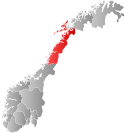Buksnes
Buksnes Municipality
Buksnes herred | |
|---|---|
 View of Gravdal and surrounding area | |
 Nordland within Norway | |
 Buksnes within Nordland | |
| Coordinates: 68°07′01″N 13°33′37″E / 68.11694°N 13.56028°E | |
| Country | Norway |
| County | Nordland |
| District | Lofoten |
| Established | 1 Jan 1838 |
| • Created as | Formannskapsdistrikt |
| Disestablished | 1 Jan 1963 |
| • Succeeded by | Vestvågøy Municipality |
| Administrative centre | Gravdal |
| Area (upon dissolution) | |
| • Total | 102 km2 (39 sq mi) |
| Population (1963) | |
| • Total | 4,416 |
| • Density | 43/km2 (110/sq mi) |
| Time zone | UTC+01:00 (CET) |
| • Summer (DST) | UTC+02:00 (CEST) |
| ISO 3166 code | NO-1860[1] |
Buksnes is a former municipality in Nordland county, Norway. The 102-square-kilometre (39 sq mi) municipality existed from 1838 until its dissolution in 1963. It comprised the western part of the island of Vestvågøya in what is now Vestvågøy Municipality. The administrative centre was located in the village of Gravdal where the main church for the municipality, Buksnes Church, is located.[2][3]
History[edit]
The municipality of Buksnes was established on 1 January 1838 (see formannskapsdistrikt law). On 1 July 1919, the southern district of Buksnes (population: 2,272) was separated from it to create the new municipality of Hol. The split left Buksnes with 3,188 inhabitants. During the 1960s, there were many municipal mergers across Norway due to the work of the Schei Committee. On 1 January 1963, the municipality of Buksnes (population: 4,416) was merged with the neighboring municipalities of Borge (population: 4,056), Hol (population: 3,154), and Valberg (population: 662) to create the new Vestvågøy Municipality.[4]
Name[edit]
The municipality (originally the parish) is named after the old Buksnes farm (historically: Buxnnæs) since the first Buksnes Church was built there. The meaning of the name is uncertain, but the first element may be derived from buks which means "sign" or "mark", possibly referring to a sea mark. The last element is nes which means "headland".[5]
Government[edit]
The municipal council (Herredsstyre) of Buksnes was made up of representatives that were elected to four year terms. The party breakdown of the final municipal council was as follows:
| Party name (in Norwegian) | Number of representatives | |
|---|---|---|
| Labour Party (Arbeiderpartiet) | 8 | |
| Conservative Party (Høyre) | 5 | |
| Christian Democratic Party (Kristelig Folkeparti) | 2 | |
| Centre Party (Senterpartiet) | 4 | |
| Liberal Party (Venstre) | 2 | |
| Total number of members: | 21 | |
| Party name (in Norwegian) | Number of representatives | |
|---|---|---|
| Labour Party (Arbeiderpartiet) | 7 | |
| Liberal Party (Venstre) | 3 | |
| Joint List(s) of Non-Socialist Parties (Borgerlige Felleslister) | 9 | |
| Local List(s) (Lokale lister) | 2 | |
| Total number of members: | 21 | |
| Party name (in Norwegian) | Number of representatives | |
|---|---|---|
| Labour Party (Arbeiderpartiet) | 10 | |
| Christian Democratic Party (Kristelig Folkeparti) | 1 | |
| Liberal Party (Venstre) | 3 | |
| Joint List(s) of Non-Socialist Parties (Borgerlige Felleslister) | 7 | |
| Total number of members: | 21 | |
| Party name (in Norwegian) | Number of representatives | |
|---|---|---|
| Labour Party (Arbeiderpartiet) | 8 | |
| Christian Democratic Party (Kristelig Folkeparti) | 1 | |
| Liberal Party (Venstre) | 3 | |
| Joint List(s) of Non-Socialist Parties (Borgerlige Felleslister) | 9 | |
| Total number of members: | 21 | |
| Party name (in Norwegian) | Number of representatives | |
|---|---|---|
| Labour Party (Arbeiderpartiet) | 10 | |
| Christian Democratic Party (Kristelig Folkeparti) | 2 | |
| Farmers' Party (Bondepartiet) | 1 | |
| Liberal Party (Venstre) | 2 | |
| Joint List(s) of Non-Socialist Parties (Borgerlige Felleslister) | 6 | |
| Total number of members: | 21 | |
| Party name (in Norwegian) | Number of representatives | |
|---|---|---|
| Labour Party (Arbeiderpartiet) | 6 | |
| Joint List(s) of Non-Socialist Parties (Borgerlige Felleslister) | 10 | |
| Total number of members: | 16 | |
| Note: Due to the German occupation of Norway during World War II, no elections were held for new municipal councils until after the war ended in 1945. | ||
Notable people[edit]
- Leonhard Christian Borchgrevink Holmboe (1802-1887), a Lutheran clergymen who was the vicar in Buksnes
- Arnold Carl Johansen (1898–1957), a member of the Norwegian Parliament from Nordland
- Gerhard Schøning (1722-1780), a historian
- Harald Sverdrup (1923–1992), a poet and children's writer
See also[edit]
References[edit]
- ^ Bolstad, Erik; Thorsnæs, Geir, eds. (2023-01-26). "Kommunenummer". Store norske leksikon (in Norwegian). Kunnskapsforlaget.
- ^ Store norske leksikon. "Buksnes – tidl. kommune" (in Norwegian). Retrieved 2012-06-23.
- ^ Helland, Amund (1908). "Buksnes herred". Norges land og folk: Nordlands amt (in Norwegian). Vol. XVIII. Kristiania, Norway: H. Aschehoug & Company. p. 619. Retrieved 2018-09-13.
- ^ Jukvam, Dag (1999). "Historisk oversikt over endringer i kommune- og fylkesinndelingen" (PDF) (in Norwegian). Statistisk sentralbyrå. ISBN 9788253746845.
- ^ Rygh, Oluf (1905). Norske gaardnavne: Nordlands amt (in Norwegian) (16 ed.). Kristiania, Norge: W. C. Fabritius & sønners bogtrikkeri. p. 333.
- ^ "Kommunevalgene og Ordførervalgene 1959" (PDF) (in Norwegian). Oslo: Statistisk sentralbyrå. 1960. Retrieved 2020-03-18.
- ^ "Kommunevalgene og Ordførervalgene 1955" (PDF) (in Norwegian). Oslo: Statistisk sentralbyrå. 1957. Retrieved 2020-03-18.
- ^ "Kommunevalgene og Ordførervalgene 1951" (PDF) (in Norwegian). Oslo: Statistisk sentralbyrå. 1952. Retrieved 2020-03-18.
- ^ "Kommunevalgene og Ordførervalgene 1947" (PDF) (in Norwegian). Oslo: Statistisk sentralbyrå. 1948. Retrieved 2020-03-18.
- ^ "Kommunevalgene og Ordførervalgene 1945" (PDF) (in Norwegian). Oslo: Statistisk sentralbyrå. 1947. Retrieved 2020-03-18.
- ^ "Kommunevalgene og Ordførervalgene 1937" (PDF) (in Norwegian). Oslo: Statistisk sentralbyrå. 1938. Retrieved 2020-03-18.

